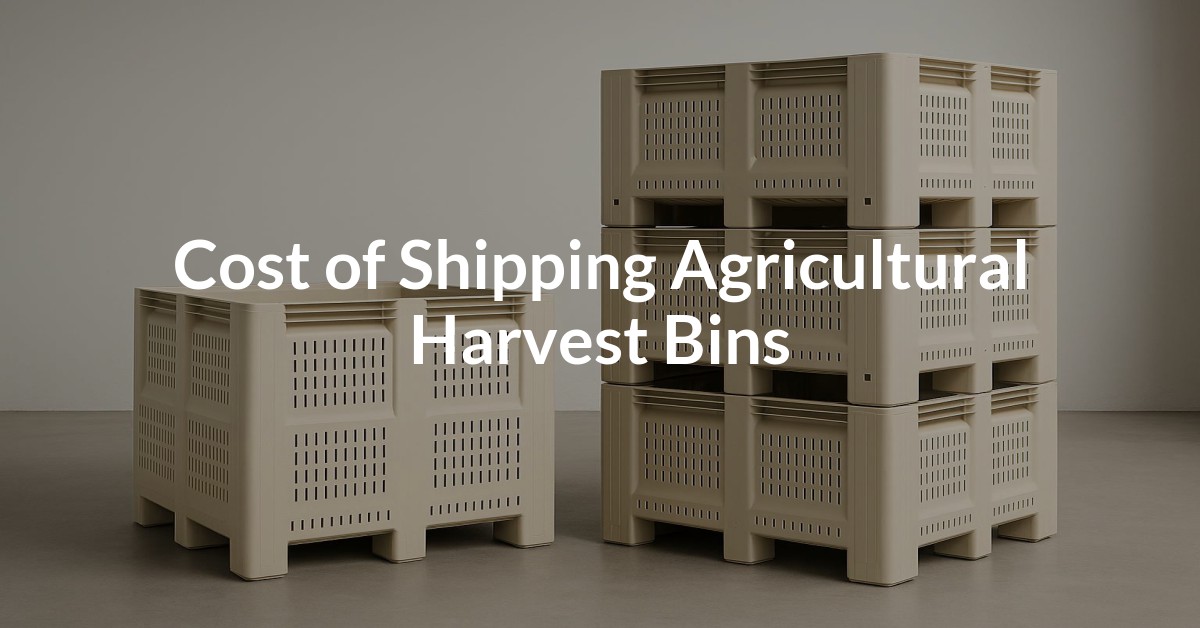Agricultural harvest bins are essential tools used for collecting, storing, and transporting crops. As farmers transition between harvests, the need to move these bins efficiently and affordably becomes vital. This article will provide a comprehensive look at the costs associated with shipping agricultural harvest bins and how FreightSidekick can help streamline the process.
Factors Influencing Shipping Costs
There are several key determinants that affect the overall cost of shipping agricultural harvest bins. Understanding these factors can aid in planning and budgeting for freight services.
- Weight and Dimensions: The size and weight of the bins directly influence shipping rates. Larger and heavier bins will require more resources, potentially increasing costs.
- Shipping Distance: The distance between the pickup and delivery locations is a primary factor. Longer distances usually equate to higher costs.
- Freight Mode: Choosing between Full Truckload (FTL), Less Than Truckload (LTL), or Partial Truckload can impact pricing. Each mode offers distinct advantages depending on shipment size and urgency.
- Special Handling Requirements: If bins require special handling, like refrigeration or temperature control, costs may rise. Additionally, bins needing specific equipment for loading/unloading can incur extra charges.
- Fuel Costs: Fluctuating fuel prices can impact freight costs as they are often included in shipping quotes.
Selecting the Right Freight Service
FreightSideKick offers a variety of freight services to accommodate different needs and budgets. Here's a breakdown of the available options:
- Full Truckload (FTL): Ideal for large shipments that fill an entire truck, ensuring direct and time-efficient delivery. Available configurations include Dry Van, Refrigerated, and Flatbed trucks.
- Less Than Truckload (LTL): Suitable for smaller volumes. Bins are shipped alongside other goods, optimizing space and reducing costs.
- Partial/Shared Truckload: Perfect for shipments that don't require a full truck but need more space than LTL. Shared resources reduce per-unit shipping costs.
- Smaller Equipment: For lighter loads, we offer box trucks and cargo vans that are ideal for quick and economical local deliveries.
Step-by-Step Guide to Shipping Harvest Bins
Follow these steps to ensure your agricultural harvest bins are shipped effectively:
- Assess Your Requirements: Determine the number and dimensions of bins that need shipping and any special handling requirements.
- Choose the Right Freight Mode: Based on your assessment, select the freight mode that fits your shipment's size and urgency.
- Get a Quote: Use the Freight Quote Tool for an instant estimate.
- Prepare the Bins for Transport: Securely pack the bins, ensuring they are clean and safely loaded for transport.
- Schedule the Pickup: Coordinate with FreightSideKick to arrange pickup at a convenient time and location.
- Track the Shipment: Utilize our tracking services to monitor the shipment until it reaches its destination.
Cost-Saving Strategies
Optimizing your shipping approach can lead to significant savings. Here are some tips to help reduce costs:
- Consolidate Shipments: Combine shipments where possible to take advantage of bulk shipping rates.
- Flexible Scheduling: If timelines allow, choose off-peak times for cheaper rates.
- Negotiate Contracts: Establish long-term contracts with freight providers for consistent and potentially discounted rates.
- Avoid Misclassification: Utilize our Freight Class Calculator to ensure the bins are correctly classified to prevent unnecessary charges.
Safety and Compliance Considerations
It's crucial to prioritize safety and regulatory compliance when shipping agricultural harvest bins to prevent delays and potential fines.
- Ensure Proper Labeling: All bins must be clearly labeled with the contents and destination to comply with shipping regulations.
- Use Appropriate Restraints: Secure bins with the right restraints to minimize movement during transit.
- Verify Licensing and Insurance: Ensure that your chosen freight service provider has the necessary licenses and insurance for transporting agricultural goods.
Get Personalized Assistance for Shipping Agricultural Harvest Bins
Navigating the logistics of shipping agricultural harvest bins doesn't have to be challenging. Our team at FreightSidekick is here to help. Get a quote today, call us at 877-345-3838 or email support@freightsidekick.com.











